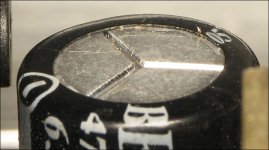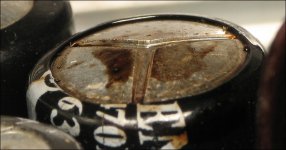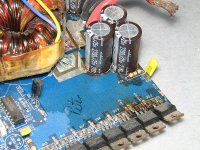Im in no way a tech guy, just curious. I found this pic online.
Are these caps starting to leak ?
Are these caps starting to leak ?
An externally hosted image should be here but it was not working when we last tested it.
With that type of can style capacitor you'll need to look near the base, where the cap is in contact with the PCB to see if they are leaking electrolyte.Are these caps starting to leak ?
Look for what could well be dried liquid or any form of liquid spill, if you can't see any you should be ok. This doesn't mean that the capacitors are still functioning as they should, just that they haven't "leaked" electrolyte 😉 The capacitance value could still be a country mile out due to age & heat.
One more. These are leaking from the bottom seal. There are two things that you need to look for. The brown liquid around the perimeter of the capacitor is where the electrolyte is highly concentrated. If you look out a bit farther, you can see that it looks like an oil has spilled on the board. It's more obvious on boards that are dusty but can be seen on clean boards if you look closely.
As a side note...
Anyone with an amp (Autotek, Hifonics...) that uses these brown Nichicon capacitors marked PF(M) should check for this to see if there is any leakage. The electrolyte can damage large areas of the board.
As a side note...
Anyone with an amp (Autotek, Hifonics...) that uses these brown Nichicon capacitors marked PF(M) should check for this to see if there is any leakage. The electrolyte can damage large areas of the board.
Attachments
.................These are leaking from the bottom seal. There are two things that you need to look for. The brown liquid around the perimeter of the capacitor is where the electrolyte is highly concentrated. ...........QUOTE]
Some manufacturers fix large caps down with with glue/cement. This can be brown or white. but usually goes up the can a little. Don't confuse with leakage.
Andy
.
.................These are leaking from the bottom seal. There are two things that you need to look for. The brown liquid around the perimeter of the capacitor is where the electrolyte is highly concentrated. ...........QUOTE]
Some manufacturers fix large caps down with with glue/cement. This can be brown or white. but usually goes up the can a little. Don't confuse with leakage.
Andy
.
be suspicious when the end seal rubber tends to show tilting the caps....
It depends on the severity of the damage. If there's simply leakage and no corrosion (rare), I'd use acetone and a toothbrush. Soap and water may work but water takes a long time to evaporate and when you need to get an amp back together quickly, it takes too long. Acetone evaporates in seconds.
I've seen several boards that had so much damage that the board had to be cut away to remove the damaged material. These were typically amps that had been in use for quite a while while the electrolyte soaked into the board. The electrolyte-soaked board began to conduct electricity from the power plane to the ground plane and that led to a larger area being damaged.
I've seen several boards that had so much damage that the board had to be cut away to remove the damaged material. These were typically amps that had been in use for quite a while while the electrolyte soaked into the board. The electrolyte-soaked board began to conduct electricity from the power plane to the ground plane and that led to a larger area being damaged.
"be suspicious", when the electronics device's age exceeds the 5 year shelf life rating that only the best quality wet caps carry from their respective Japanese and American makers. 2 years lifespan ratings are typical nowadays...
Leakage is the final sign that they need to be replaced.
And I agree with Perry also, I have seen the copper traces dissolved by the electro-chemical reaction of power passing through the electrolyte across the board. And i have also seen the fiberglass board burn up from the heat generated by the shorted conditions of the electrolyte across the power supply rails, and other short circuits caused by conductive liquid issues.
None of which were a pretty site, nor was it a easy thing to repair reliably and safely in many cases. In some cases I have returned said damaged gear to clients with my sympathies. It was just too damaged to provide a reliable service without major board area replacement, and even then if something was to happen later on the liability of said repairs are just out of the question from a insurance point of view....
I also upon cap replacement, barrier up the area between the electrodes with a barrier of Silicone based RTV. This prevents arc over by the electrolyte shorting between the conductors when the wet caps eventually do leak again. As leakage is fact of wet cap life...This also helps reduce vibration related shock issues to the seals by lessening the tendency of the vertical standing cap to vibrate on its leads.... hope this tid-bit helps others like it has me over the years....🙂
Leakage is the final sign that they need to be replaced.
And I agree with Perry also, I have seen the copper traces dissolved by the electro-chemical reaction of power passing through the electrolyte across the board. And i have also seen the fiberglass board burn up from the heat generated by the shorted conditions of the electrolyte across the power supply rails, and other short circuits caused by conductive liquid issues.
None of which were a pretty site, nor was it a easy thing to repair reliably and safely in many cases. In some cases I have returned said damaged gear to clients with my sympathies. It was just too damaged to provide a reliable service without major board area replacement, and even then if something was to happen later on the liability of said repairs are just out of the question from a insurance point of view....
I also upon cap replacement, barrier up the area between the electrodes with a barrier of Silicone based RTV. This prevents arc over by the electrolyte shorting between the conductors when the wet caps eventually do leak again. As leakage is fact of wet cap life...This also helps reduce vibration related shock issues to the seals by lessening the tendency of the vertical standing cap to vibrate on its leads.... hope this tid-bit helps others like it has me over the years....🙂
Last edited:
So why are you asking Rob? Do you think one of the amps you bought has some issues?
No man.
I was on ampguts looking at pics and I was just curious. 😛
Im trying to become an amp expert like you.
No man.
I was on ampguts looking at pics and I was just curious. 😛
Im trying to become an amp expert like you.
Hmmm i see. LOL....
- Status
- Not open for further replies.
- Home
- General Interest
- Car Audio
- What do leaky caps look like ?


